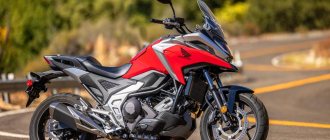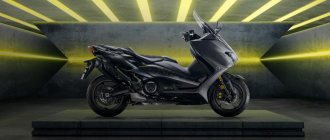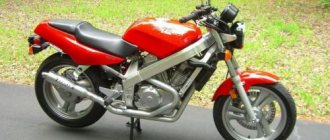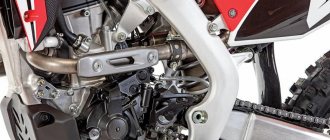| Yamaha YZ250F (2001-2005) | Yamaha YZ250F (2006) | Yamaha YZ250F (2007-2009) |
| Yamaha YZ250F (2010-2013) | Yamaha YZ250F (2014-2018) | Yamaha YZ250F (2019-2020) |
| Yamaha YZ250F (2021) | Yamaha YZ250F (2022+) | Yamaha YZ250F Monster Energy Yamaha Racing Edition (2022) |
Yamaha YZ250F motocross model
appeared in 2001 as a 4-stroke motocross model designed to replace the 2-stroke Yamaha YZ250. It should be noted that this step was taken by the entire Japanese “quartet” of motorcycle manufacturers, the only difference being that 2-stroke motocross motorcycles from Yamaha were so successful that they continue to be produced in parallel with 4-stroke ones and even compete in the same racing class.
The Yamaha YZ250F was based on a 1-cylinder 4-stroke liquid-cooled engine with a volume of 249 cm³, with 5 valves, producing about 42 hp. power and 29 Nm of torque.
In 2006, the model underwent a major update, the main innovation of which was the transition from a steel to an aluminum frame. It was from this moment that the YZ250F model became a full-fledged player in the market of motocross models with an engine capacity of up to 250 cm³.
For 2008, the model receives a new engine that has been further optimized, slightly increasing maximum power and torque characteristics.
For 2010, the Yamaha YZ250F gets a new fork and repositions the engine in the frame to lower the center of gravity and improve handling. Overall optimization allowed us to achieve a record curb weight of 102 kg.
2014 marked the new generation of the Yamaha YZ250F. The motorcycle received a new front fork, a new engine with an injection power system and an increased compression ratio (from 12.5 to 13.5), a 4-valve cylinder head (instead of 5-valve). In 2016, the model received a new front brake disc (diameter increased from 250 to 270 mm).
In 2022, Yamaha again updates the YZ250F, which, in addition to changes in appearance, receives a new engine (the compression ratio increases from 13.5 to 13.8), a new rear shock absorber (the settings have been changed) and an electric starter.
For 2022, Yamaha has introduced a new generation of the YZ250F. The updated model received a new cylinder head, control unit, intake system, modified frame, new suspension settings and an updated brake system (updated calipers, discs, brake pads, rear disc diameter reduced from 245 to 240 mm).
Yamaha is releasing an updated YZ250F at the end of 2022. The new model received a wider rear wheel (100 → 110 mm), updated graphics and optimized suspension settings.
The Yamaha WR250 enduro series and the Yamaha YZ250FX hard enduro series (available since 2015) were built on the basis of the Yamaha YZ250F.
The main competitors of the Yamaha YZ250F in the class:
- Honda CRF250R
- Kawasaki KX250F
- Suzuki RM-Z250
Brief history of the model
- 2001 - Model
: Yamaha YZ250F (All markets).
Factory designation
: 5NL1, 5NL2, 5NL3, 5NL4.
- 2002 - Model
: Yamaha YZ250F (All markets).
Factory designation
: 5SG1, 5SG2, 5SG3, 5SG4.
- 2003 - Model
: Yamaha YZ250F (All markets).
Factory designation
: 5UL1, 5UL2, 5UL3, 5UL4.
- 2004 - Model
: Yamaha YZ250F (All markets).
Factory designation
: 5XC1, 5XC2, 5XC3, 5XC4.
- 2005 - Model
: Yamaha YZ250F (All markets).
Factory designation
: 5XC5, 5XC6, 5XC7, 5XC8.
- 2006 - Model
: Yamaha YZ250F (All markets).
Factory designation
: 5XC9, 5XCA, 5XCB, 5XCC, 5XCD, 5XCE, 5XCF.
- 2007 - Model
: Yamaha YZ250F (All markets).
Factory designation
: 5XCG, 5XCH, 5XCJ, 5XCK.
- 2008 - Model
: Yamaha YZ250F (All markets).
Factory designation
: 5XCL, 5XCM, 5XCN, 5XCP.
- 2009 - Model
: Yamaha YZ250F (All markets).
Factory designation
: 5XCR, 5XCS, 5XCT, 5XCU.
- 2010 - Model
: Yamaha YZ250F (All markets).
Factory designation
: 17D5, 17D6, 17D7.
- 2011 - Model
: Yamaha YZ250F (All markets).
Factory designation
: 17DD, 17DE, 17DF.
- 2012 - Model
: Yamaha YZ250F (All markets).
Factory designation
: 17D9, 17DA, 17DB.
- 2013 - Model
: Yamaha YZ250F (All markets).
Factory designation
: 17DH, 17DJ, 17DK.
- 2014 - Model
: Yamaha YZ250F (All markets).
Factory designation
: 1SM1, 1SM2, 1SM3.
- 2015 - Model
: Yamaha YZ250F (All markets).
Factory designation
: 1SM5, 1SM6, 1SM7.
- 2016 - Model
: Yamaha YZ250F (All markets).
Factory designation
: 1SM9, 1SMA, 1SMB, 1SMD, 1SMF, 1SMG.
- 2017 - Model
: Yamaha YZ250F (All markets).
Factory designation
: 1SME, 1SMJ, 1SMK.
- 2018 - Model
: Yamaha YZ250F (All markets).
Factory designation
: 1SMM, 1SMN, 1SMP.
- 2019 - Model
: Yamaha YZ250F (All markets).
Factory designation
: YZ250FKL, YZ250FKW.
- 2020 - Model
: Yamaha YZ250F (All Markets).
- 2021 - Model
: Yamaha YZ250F (All Markets).
- 2022 - Model
: Yamaha YZ250F (All Markets).
Yamaha yz250f chassis and handling
Last year's chassis update had a pretty significant impact on the handling of the Yamaha YZ250F, and improvements for the 2022 model year have improved it even further. The bike handles sharper but retains incredible stability, which is especially noticeable on fast, rough trails. The YZ250F doesn't feel like it dives into corners quite as sharply as the Honda CRF250R or Suzuki RM-Z250, which turn in a breeze, but the Yamaha still steers well, requiring a small but conscious effort to lean into a turn, which it takes with confidence and precision.
Regarding the ergonomics of the Yamaha YZ250F, the first thing you notice is the position of the handlebars. In the upper yoke there are not two, but four holes for installing spacers, a pair of near ones and a pair of distant ones, and the spacers themselves can be installed turning forward or backward, and thus, four options for the steering wheel position are available. The stock handlebars are set to third, with the spacers in the front holes facing back, and Yamaha says they chose this position because it transfers more weight to the front wheel, which improves traction in corners.
For short people, a closer steering wheel position is more suitable, otherwise you will have to reach for it at times. It’s best to clarify this question for yourself in advance, on quiet rides, try all the options and choose the best one. Either way, having a choice is great.
Specifications
Yamaha YZ250F Specifications:
| Model | Yamaha YZ250F |
| Motorcycle type | cross |
| Year of issue | 2001+ |
| Frame | Steel half-duplex – YZ250F (2001-2005) Aluminum half-duplex – YZ250F (2006+) |
| engine's type | 1-cylinder, 4-stroke |
| Working volume | 249 cm³ |
| Bore/Stroke | 77.0 x 53.6 mm |
| Compression ratio | 12.5 – YZ250F (2001-2013) 13.5 – YZ250F (2014-2018) 13.8 – YZ250F (2019+) |
| Cooling | liquid |
| Number of valves per cylinder | DOHC, 5 valves – YZ250F (2001-2013) DOHC, 4 valves – YZ250F (2014+) |
| Fuel supply system | Carburetor, 1x Keihin FCR-MX37 – YZ250F (2001-2013) Injector, 1x 44 mm – YZ250F (2014+) |
| Ignition type | CDI - carburetor versions TCI - injection versions |
| Maximum power | 42.0 hp (30.9 kW) at 10500 rpm – YZ250F (2001-2007) 42.8 hp (31.5 kW) at 10500 rpm – YZ250F (2008-2010) |
| Maximum torque | 28.4 Nm (2.9 kg-m) at 8500 rpm - YZ250F (2001-2007) 29.5 Nm (3.0 kg-m) / 8500 rpm - YZ250F (2008-2010) |
| Clutch | Multi-disc in oil bath, cable drive |
| Transmission | 5-speed |
| type of drive | chain |
| Front tire size | 80/100-21 51M |
| Rear tire size | 100/90-19 57M 110/90-19 62M — 2022+ |
| Front brakes | 1 disc, 250 mm, 2-piston caliper – YZ250F (2001-2015) 1 disc, 270 mm, 2-piston caliper – YZ250F (2016+) |
| Rear brakes | 1 disc, 245 mm, 1-piston caliper 1 disc, 240 mm, 1-piston caliper – YZ250F (2021+) |
| Front suspension | 48mm inverted fork (fully adjustable), 300mm travel – YZ250F (2001-2013) 48mm inverted fork (fully adjustable), 310mm travel – YZ250F (2014+) |
| Rear suspension | Pendulum with monoshock absorber (fully adjustable), travel - 315 mm - YZ250F (2001-2005, 2014-2018) Swingarm with monoshock absorber (fully adjustable), travel - 310 mm - YZ250F (2006-2009) Swingarm with monoshock (fully adjustable), travel - 317 mm - YZ250F (2019+) |
| Motorcycle length | 2165 mm – YZ250F (2001-2005, 2014-2018) 2176 mm – YZ250F (2006) 2160 mm – YZ250F (2007-2013) 2175 mm – YZ250F (2019+) |
| Motorcycle width | 827 mm – YZ250F (2001-2005) 815 mm – YZ250F (2006) 825 mm – YZ250F (2007+) |
| Motorcycle height | 1303 mm – YZ250F (2001-2005, 2010-2013) 1292 mm – YZ250F (2006) 1299 mm – YZ250F (2007-2009) 1280 mm – YZ250F (2014-2018) 1285 mm – YZ250F (2019+) |
| Wheelbase | 1475 mm – YZ250F (2001-2005, 2014+) 1485 mm – YZ250F (2006) 1469 mm – YZ250F (2007-2009) 1466 mm – YZ250F (2010-2013) |
| Seat height | 998 mm – YZ250F (2001-2005) 983 mm – YZ250F (2006) 984 mm – YZ250F (2007-2009) 988 mm – YZ250F (2010-2013) 965 mm – YZ250F (2014-2018) 970 mm – YZ250F (2019+) |
| Minimum ground clearance (clearance) | 382 mm – YZ250F (2001-2005) 369 mm – YZ250F (2006) 370 mm – YZ250F (2007-2009) 375 mm – YZ250F (2010-2013) 325 mm – YZ250F (2014-2018) 335 mm – YZ250F (2019+) |
| Acceleration 0-100 km/h (0-60 mph) | |
| Maximum speed | |
| Gas tank capacity | 8.0 L – YZ250F (2001-2005) 7.0 L – YZ250F (2006-2009) 6.4 L – YZ250F (2010-2013) 6.2 L – YZ250F (2019+) |
| Motorcycle weight (dry) | 93.5 kg – YZ250F (2006) 92.7 kg – YZ250F (2007-2009) |
| Motorcycle weight (curb) | 104.5 kg – YZ250F (2001-2005) 102.0 kg – YZ250F (2010-2013) 105.0 kg – YZ250F (2014-2018) 106.0 kg – YZ250F (2019+) |
Dimensions and weight
If we talk about weight, then the motorcycle filled with all the necessary ingredients (1 liter of oil + 6 liters of fuel) is only 106 kg. Net weight less than 100 kg.
A tenacious and powerful “crossover”, which has collected many positive qualities from its predecessors.
The model is designed taking into account athletes of tall and medium height. Short stature may cause some difficulty in placing your feet on the ground.
- Length - 2162 mm.
- Width - 828 mm.
- Height - 1307 (total), 900 (at the saddle) mm.
- Base - 1469 mm.
- Ground clearance - 375 mm.
Reviews
Yamaha YZ250F reviews:
The suspension of the updated Yamaha YZ250F may not seem the softest at first; the usual inverted telescopic fork is actually completely inherited from its predecessor due to its high reliability. At the rear, the designers also installed the KYB monoshock absorber, which has repeatedly proven its quality, working in tandem with an aluminum pendulum. The suspension can be easily adjusted, and the shock absorber travel of 300 mm at the front and 312 mm at the rear is more than enough to handle any bumps and hard landings.
The brakes are great too, with a twin-piston caliper up front gripping the 250mm disc firmly and responding instantly to the handlebar lever. Her effort is more than enough to stop a motorcycle weighing more than 100 kilograms in a split second. To assist the front brake, the rear wheel has another 245mm disc with a single-piston caliper. The brakes do their job well on any type of surface, but that's also thanks to the Bridgestone M404-A tires up front and M403 tires at the rear, which bite into dirt, gravel and asphalt equally well.
The Yamaha YZ250F is not a cheap cross bike; its price tag in dealer showrooms starts at over 360,000 rubles. But this motorcycle is worth the money, especially if you buy it not for weekend rides, but to write a history of victories. Such a goal justifies any means.
Advantages and disadvantages
The yz 250 model has a number of advantages due to which the demand for the motorcycle has not decreased over the years.
- Excellent dynamic characteristics.
- Small dimensions and weight.
- Power that few models can boast of.
- Comfortable fit.
- Reliable suspension with long travel.
- Stylish and laconic design.
Judging by the reviews of the owners, the Yamaha yz 250 has a minimum of shortcomings. For example, some motorcyclists note its uncertain behavior in sharp turns, the uncomfortable shape of the steering wheel, and also a rather weak front brake. Externally, the 250 cc model almost completely copies its more powerful brother - the YZ 450. The high cost (about 300 thousand rubles) and the lack of new models without mileage in Russia are also a disadvantage of the motorcycle. In general, the model may deserve the attention of lovers of expensive cross-country two-wheeled vehicles.
Pros of the Yamaha YZ250
What did we like?
- Traction. More traction in the middle would be better, but this applies to any motorcycle in general.
- Suspension. The Kayaba SSS fork and shock absorber are ready to win straight from the store, even despite their advanced age.
- Service. It doesn't take a mechanical genius to keep a YZ250 running. This makes the model more affordable for any budget.
- Reliability. She's like a rabbit from an advertisement: she works and works and works.
Suspension
What's so special about the Kayaba SSS suspension?
Every test says the same thing:
Kayaba SSS components have been ahead of the curve for 13 years since their introduction in 2006. Kayaba SSS has rightfully held the title of best stock suspension ever since its introduction. The SSS fork has excellent flat-out resistance and excellent damping. This is one of the best forks available today, and even the new Suzuki RM-Z450, Honda CRF450 and Kawasaki KX250F spring forks can't compare to the SSS.
What makes SSS such a serious player? Yamaha's goal for 2006 was to improve the early-stroke damping of the fork so that it wasn't too stiff at the end of travel. In 2006, Yamaha engineers wanted to raise the working position of the Yamaha YZ250 fork so that small bumps would not cause it to fold and it would always be ready for heavy loads. How did they achieve this? Before the SSS fork, the performance of a typical motocross fork was 70% position dependent. This means that its stiffness was determined by the position of the piston in the rod: in a nutshell, the deeper the piston, the stiffer the fork.
And that was the idea behind the Kayaba SSS: its stiffness is 90% dependent on speed. That is, the faster the piston moves, the stiffer the fork becomes, and only 10% of the stiffness depends on the position of the piston. By going from 30% speed sensitivity to 90%, Yamaha has found the sweet spot in fork performance. All subsequent Yamaha forks have received linear SSS smoothing, with no maximum or minimum in the smoothing characteristics. It increases stiffness equally at the beginning of the stroke and at the end. The smoothing and spring characteristics changed over the years, but Yamaha engineers were careful enough to handle these changes and managed not to degrade what worked well.
Yamaha YZ250 2019
Yamaha YZ 250 F: first races
Last but not least among the 2009 250cc Japanese motocross bikes reviewed, the Yamaha was quick to grab the attention of our testers: its white design was considered the most successful in the category. After the corny red Honda and the corny yellow Suzuki, the originality of the YZ 2009 attracts with various details, such as black Excel rims, black engine crankcases, smooth lines starting from the ramie and ending with a beautiful pendulum.. The Japanese quarter shows class!! Similar thoughts about the configuration, where it is immediately clear that the manufacturer has accumulated considerable experience in the production of such motorcycles. Our riders especially liked the quick adjustment of the throttle free play and steering wheel position. You can tilt it forward without much delay, making it easier to load the front for faster turning. Or tilt it more back, which increases stability and is necessary on high-speed tracks and in sand.
Controllability
How does the 2022 Yamaha YZ250 handle?
In short, if you liked the 2022 version, you'll like this one. And in short: there's nothing much to say about its handling, because it just does everything right. Its straight-line stability is not sacrificed for turning, it is nimble without sacrificing accuracy, and rigid without sacrificing tractability. In three words: predictable, stable workhorse (okay, let's say in four). Perhaps this did not sound like ecstatic praise, but this is precisely because there is no reason for ecstasy here. The 2022 Yamaha YZ250 isn't the best handling, but it's good enough to win races.
Power
How fast is she?
Yamaha and KTM have long been firmly stuck in the struggle between “old and new.” The 2022 KTM 250SX is a lot more powerful than the YZ250, but that doesn't mean it's faster. On the dyno, the KTM produces 47.2 hp and the YZ250 46.08, but keep in mind that the Yamaha YZ250 peaks at 8,800 rpm, while the 250SX peaks at 8,200. The difference at peak is about 1 horsepower. force, and this is very little in real conditions, but the nature of the thrust distribution of these engines is very different.
On the move, the KTM 250SX has significantly more torque from low to mid-range, and is up 4 hp. more powerful than the Yamaha YZ250 at 7000 rpm. He shoots powerfully, pulls powerfully and runs out of steam early. Four horses at mid-range is a lot, but it runs out of steam at 8200, and the Yamaha at peak 8800 is 4.7 horsepower more powerful than the KTM. The KTM 250SX is great from the bottom up and the Yamaha YZ250 is awesome up top. It's interesting how different it feels to ride a crowbar at the bottom versus a classic motocross power top. The Yamaha YZ250 engine feels more manageable and comfortable than the more powerful KTM 250SX.
2022 Yamaha YZ250FX On the Go
Thanks to the use of an updated version of the engine from the YZ250F, including a new piston, increased compression ratio, updated timing and valve timing, the traction character of the Yamaha YZ250FX has significantly improved compared to the previous (until 2022) version. The pull is extremely smooth and controllable, but with powerful low end and improved high end. The elastic engine suits the FX extremely well due to the wide box, which has an extremely low first gear and high fifth and sixth gears, like on a drag bike. So, excellent acceleration from the bottom and effective high revs allow the YZ250FX to pull in any situation, even when riding tightly at the bottom, even when revved up to the point of ringing. The only caveat is that don’t forget to download Power Tuner and replace the stunted card with an aggressive one.
The gearbox, surprisingly, is quite sane on the cross-country track, but on the off-road route there were some nuances. On the cross-country, there are enough from the second to the fourth, which are not far from the cross-country box as a whole, and in an open-country race you don’t really go below fourth, but at the same time they are quite widely spaced, and there is a feeling that somewhere between them there is another one missing transfers. However, this is where the aggressive card came in handy.
Kayaba suspensions, for all their perfection, are still extremely softly tuned. This is easy to appreciate in rocky or root-strewn areas where they will swallow literally anything, but in fast open areas their softness becomes a disadvantage. For open country racing, it makes sense to put YZ250F springs in the fork, tighten the adjusters and raise the oil level.
All these features clearly make the Yamaha YZ250FX a great off-road bike, but not a great motocross bike. It is too soft, too slow, too heavy and clumsy for serious cross-country. It can be modified to decent motocross condition by replacing the suspensions, updating the ECU maps, adding an aftermarket muffler and selecting the most suitable sprockets (probably increasing the rear sprocket to improve performance in second to fourth gears).
Still, it's a great bike and a lot of fun to ride. Moreover, it is reliable enough to travel to uninhabited places - desert, mountains, forests.
Yamaha YZ250FX










